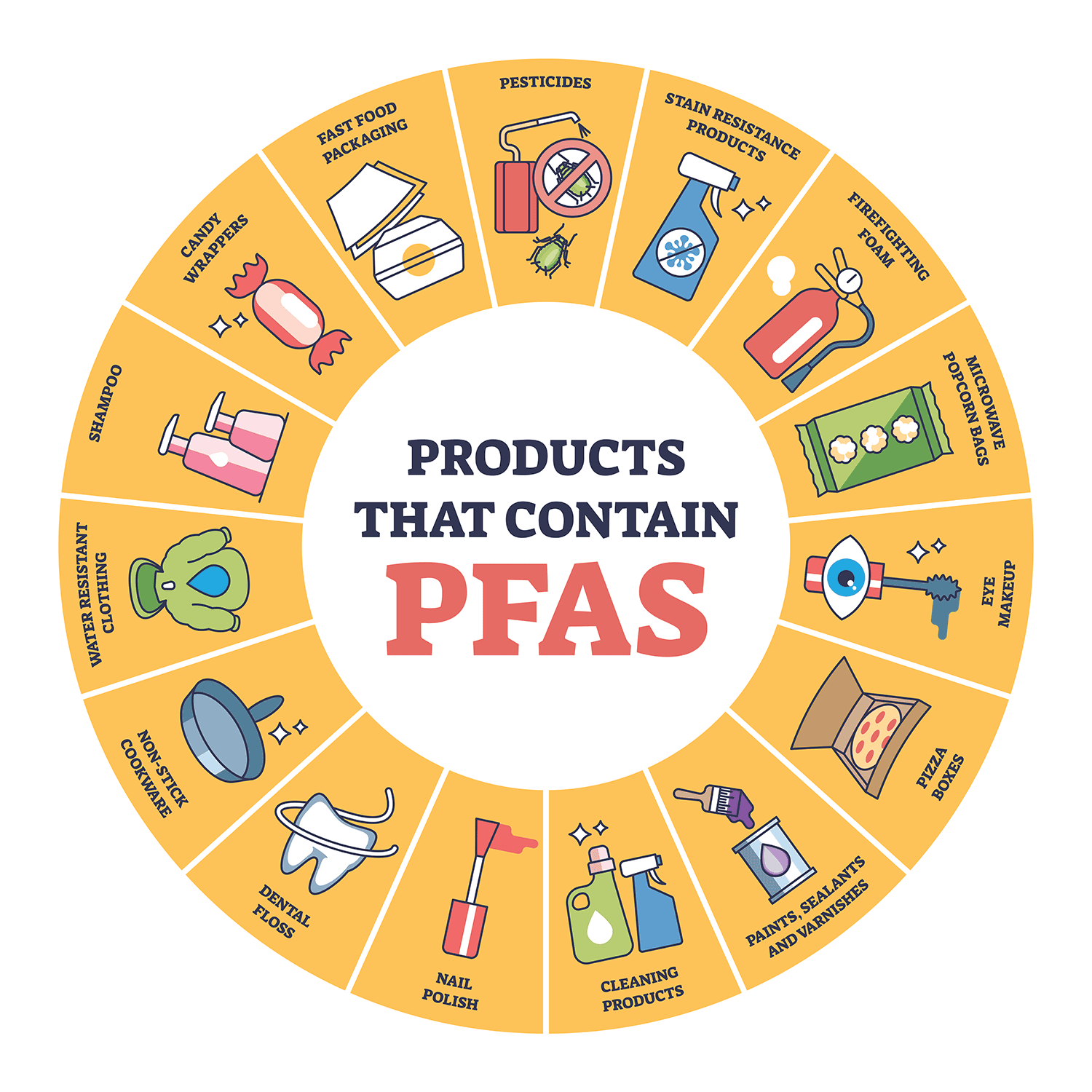What are PFAS?
PFAS are found almost everywhere — from packaging to cookware, to clothing and carpets. PFAS, which stands for per- and polyfluoroalkyl substances, are a group of complex manmade chemicals desired for their water-, stain-, and grease-resistant properties that have been widely used in consumer goods and various industries since the 1940s. These substances have earned the label “forever chemicals” because, as the National Institute of Environmental Health Sciences reports, the very strong carbon-fluorine bonds that make PFAS molecules an attractive choice to use in products, also makes them difficult to degrade in the environment and in our bodies.
The widespread use of PFAS and their persistence in the environment has led to the discovery of PFAS in the blood of people and animals, and there’s evidence of low levels in some foods. Scientific studies cited by the United States Environmental Protection Agency (EPA) show that exposure to some PFAS may link to harmful health concerns. Some of the possible health risks include cancer, birth weight and developmental issues, compromised immune systems, and reproductive effects.
How are we exposed to PFAS?
Almost everyone has been exposed to some PFAS. According to the EPA, PFAS can be present in our water, soil, air, and in materials around us including: drinking water, waste wastewater, certain manufacturing facilities, consumer products (such as shampoos, cosmetics, some carpets and fabrics, non-stick cookware, and paints and varnishes), food packaging, fire extinguishing foam, biosolids, and food (such as fish caught from water contaminated by PFAS and dairy products from livestock exposed to PFAS).
The use of PFAS chemicals is widespread but exposure varies based on geography and industry. One of the primary exposure routes is through drinking water. In 2024, the U.S. EPA announced the National Primary Drinking Water Regulations (NPDWR) for six PFAS, establishing legally enforceable Maximum Contaminant Levels (MCLs).
What are the requirements of the NPDWR PFAS regulations?
The following are the new EPA MCLs:

The NPDWR requires that public water systems monitor for these PFAS. They have three years to complete initial monitoring (by 2027) with ongoing compliance monitoring. Water systems must also provide the public with information on the levels of these PFAS in their drinking water by 2027. Public water systems have until 2029 to implement solutions to reduce PFAS if monitoring shows that drinking water levels exceed the MCLs. Starting in 2029, if any public water systems exceed any one of the MCLs, action to reduce the levels must be taken and the public must be notified of the violation.
The Environmental Working Group provides a map of collected data from the EPA’s quarterly public water system testing. The map shows PFAS exposures above or below the new EPA MCLs as of November 2024. This data highlights the scale of PFAS exposure in the US.

In addition to the drinking water standard, EPA has also finalized TSCA Section 8(a)(7) Reporting and Recordkeeping Requirements for Perfluoroalkyl and Polyfluoroalkyl Substances. Under this rule, “EPA is requiring any person that manufactures (including import) or has manufactured (including imported) PFAS or PFAS-containing articles in any year since January 1, 2011, to electronically report information regarding PFAS uses, production volumes, disposal, exposures, and hazards.” (The EPA has delayed the beginning of this reporting period until July 2025 due to budgetary constraints.)
What’s next for you
Eradicating PFAS exposure may be impossible due to the permeation in our society. As PFAS continues to be studied, it becomes more evident that exposure is all around us in some form and even at low levels, PFAS can present various risks to health. The NPDWR is designed to help reduce those risks by establishing maximum containment level guidelines and reporting so that you will understand the toxicity in your geographic area and corrective solutions can be implemented. While the MCLs are limited to the most researched PFAS chemicals, treatment technologies installed to comply with the MCLs may effectively treat additional PFAS, which will reduce the total PFAS levels in drinking water. More research and effective solutions are a priority for the EPA.
IPA Laboratories is closely following PFAS research and regulations to be prepared for testing needs as they evolve and to help answer your questions.
